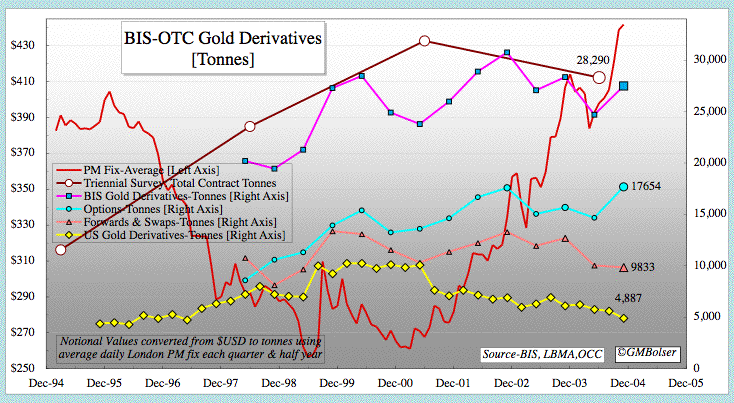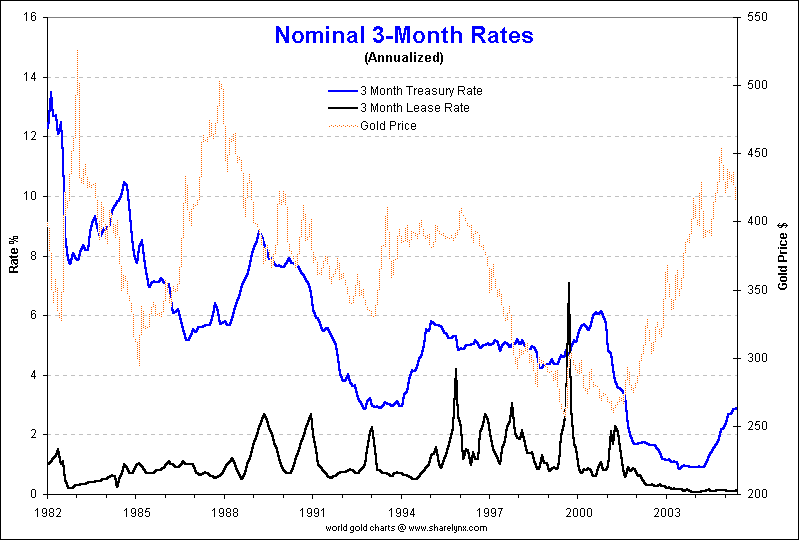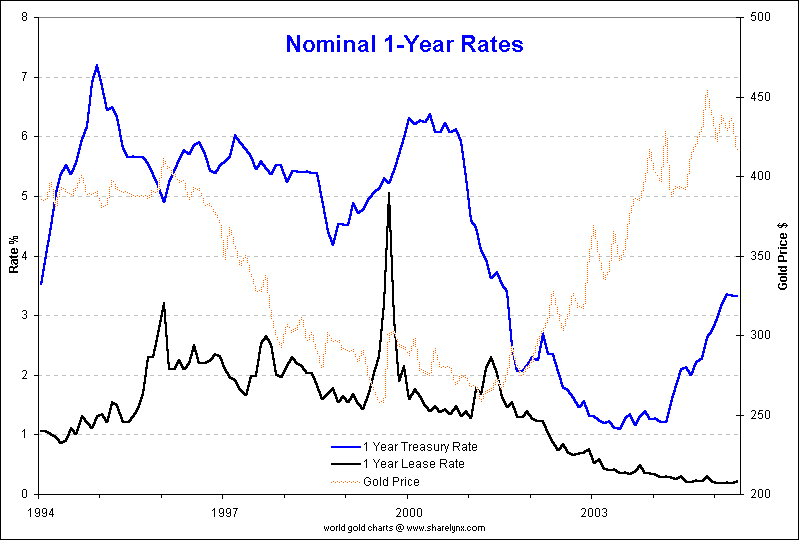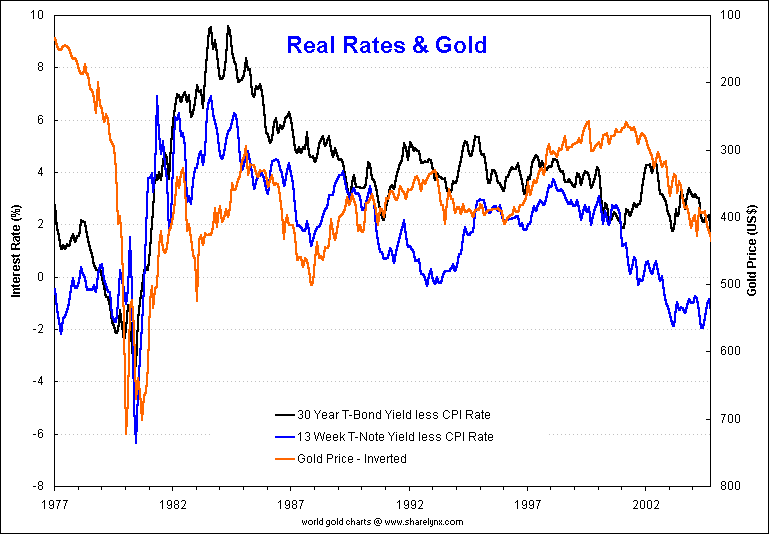CURRENT COMMENTARIES November 11, 2005. New Essay by Bob Landis
In a timely new essay, After Monetary Collapse: Strict Reconstruction or More Bork?, Bob Landis expands on his remarks at Gold Rush 21, The GATA Gold Conference, August 8-9, 2005, Dawson City, Yukon, Canada.
June 15, 2005 (RHH). Gold Derivatives: Skewing the World
On May 20, 2005, the Bank for International Settlements released its regular semi-annual report on the over-the-counter derivatives of major banks and dealers in the G-10 countries for the period ending December 31, 2004. The total notional value of all gold derivatives rose from $318 billion at mid-year 2004 to $369 billion at year-end. As subsequently detailed in table 22A of the June issue of the BIS Quarterly Review, released June 13, 2005, forwards and swaps increased slightly from $129 to $132 billion while options rose dramatically from $189 to $237 billion.
The huge increase in options alongside a stationary dollar level -- and apparently falling tonnage level -- of forwards and swaps suggests that official efforts to control gold prices are placing increasing reliance on the use of call options written by the central banks to provide delta hedges for short sales by the bullion banks, whether of borrowed physical or paper gold. Options have risen sharply against flat to falling forwards and swaps only once before: during the first full six-month period after the panic rally in gold prices precipitated by announcement of the Washington Agreement on Gold (WAG) in late September 1999. See The New Dimension: Running for Cover (2/14/2000).
The New Alchemy. Translated into estimated tonnes, these figures are shown below in an updated (and slightly corrected) version of the chart by Mike Bolser that has illustrated past commentaries on this data. A principal thesis of all these commentaries is that the total notional value of forwards and swaps as reported by the BIS and converted into tonnes is a pretty good proxy for the total net short physical position in gold arising largely as the result of gold lending in one form or another by central banks. See, e.g., Hard Money Markets: Climbing a Chinese Wall of Worry (6/28/2004) and Gold Derivatives: Hitting the Iceberg (12/20/2003). However, the recent huge increase in options suggests that the central banks are now building a growing short physical exposure here too.
Also shown in tonnes in Mike's chart are the gold derivatives held by U.S. commercial banks as reported through December 31, 2004, by the Office of the Comptroller of the Currency (www.occ.treas.gov/deriv/deriv.htm). The total notional value of these gold derivatives -- held almost entirely by J.P. Morgan Chase, HSBC USA and Citibank -- has declined over the past several quarters. Curiously, the rate of decline accelerated during the last half of 2004 while total gold derivatives as reported by the BIS were rising quite sharply.
The aggressive reductions in total forward sales made by gold producers in 2004 appear to have had an impact on the total level of forwards and swaps reported by the BIS. However, although on a downward slope from their past highs, the BIS's figures for forwards and swaps show nothing like the large scale reductions of well over 50% reported in total producer hedge books since 2001. Nor does the composition of the global producer hedge book, which consists of roughly 80% forwards and 20% options, parallel the BIS data. See, e.g., Gold Fields Minerals Services, Global Gold Hedge Book Analysis - Q1 2005 (May 2005), and prior editions.
Even at their peaks, total producer hedge books of less than 5000 tonnes were never sufficient to account for the bulk of total gold derivatives reported by the BIS, most of which appear to be attributable not to producer hedging but to bullion banks funding themselves through the gold carry trade while simultaneously assisting the central banks to suppress gold prices. See Déjà Vu: Central Banks at the Abyss (12/7/04).
Market Values. The BIS data also includes figures on gross market values, which in the case of gold have moved erratically and not infrequently in the opposite direction of notional values. For each of the four six-month reporting periods from end-June 2003 to end-December 2004, these figures for total gold derivatives were $12, $39, $45 and $32 billion, respectively. In the gold, other precious metals and other commodities categories, the BIS does not give separate market values for forwards and swaps and for options.
Market values for OTC derivatives are always a bit suspect because most are illiquid and their values must be determined by calculation rather than from true market prices. Besides eliminating double counting between reporting entities as is done for notional amounts, the BIS nets gross positive market values against gross negative values and gives effect to legally enforceable bilateral netting agreements. Counterparty risk is not considered. All counterparties are deemed equally credit-worthy. In the case of gold derivatives, this assumption disregards the unique risk presented by contracts under which payment in physical gold may be required, especially where the delivery obligation rests on an entity other than a gold producer or central bank.
As a measure of risk, market values are best suited to circumstances where the underlying or reference asset fluctuates within its recent or assumed price and volatility parameters. But market values are less useful in the event of large, sudden or unanticipated changes in either price or volatility. The risk associated with an "ordinary" 5-10% move in gold prices over several weeks or months may be captured reasonably well by market values. However, notional values probably give a better indication of the risk associated with a 20-50% move over a week or weekend, such as might accompany some sort of financial crisis or accident and which, just as importantly, would likely increase the demand for settlement through physical delivery.
Theory versus Reality. As Emanuel Derman, former head of derivatives and risk strategies at Goldman Sachs, recently explained (Grant's Interest Rate Observer (April 22, 2005), p. 8):
In physics, a model is right when it correctly predicts the future trajectories of some satellite.... In finance, you can't easily prove a model is right by observation. Models are complicated, data is scarce, and, more importantly, markets aren't stationary. Markets are arenas of action and reaction. There's thesis, and then there's antithesis, and then there's synthesis. And people learn from past mistakes and go on to be free to make new ones. And what is right in one regime is wrong in the next. I've seen this even in options markets, where there's something called the volatility skew that sort of violates Black-Scholes, and once upon a time it existed only in equities. And, as people in the gold market got smarter, this phenomenon started to appear in the gold market, which previously had more or less satisfied Black-Scholes. [Emphasis supplied.]
The Black-Scholes options pricing formula involves the application of higher mathematics to several variables, of which all except volatility are conventionally observable. Generally speaking, higher volatility results in higher option prices. The formula assumes that the historic volatility of the underlying or reference asset will remain constant both over time and without regard to changes in its price. Where an options market is sufficiently liquid, the Black-Scholes formula may be worked in reverse to calculate an implied volatility for the reference asset based on quoted market prices for the options.
When implied volatility deviates materially from historic volatility, the formula and the market are at odds with each other, and while both cannot be correct, both can be wrong. Following the 1987 stock market crash, well out-of-the-money equity and equity index puts were priced to indicate an implied volatility considerably in excess of historic norms. In the fall of 1999, a similar phenomenon was observed in call options on gold following the sharp rally in prices caused by announcement of the WAG.
Significant divergences or skews between implied and historic volatility offer inviting trading opportunities to those who believe in the principle of reversion to the mean. Indeed, such trades were a favorite of Long Term Capital Management. See R. Lowenstein, When Genius Failed (Random House Paperback Edition, 2001), pp. 123-126, including some cautionary advice from Lord Keynes: "Markets can remain irrational longer than you can remain solvent." But quants are not easily discouraged, and the search for better methods of predicting volatility continues. See, e.g., N.A. Chriss, Black-Scholes and Beyond - Option Pricing Models (McGraw-Hill, 1997).
WAG the COMEX. Since derivatives contracts on the OTC markets are not standardized, open interest is measured by notional amounts rather than by number of contracts as is customary for exchange traded futures and options. In the case of gold futures or options on the Commodities Exchange in New York, it requires 321,500 contracts to amount in notional value to 1000 tonnes. As the following chart by Don Lindley illustrates, COMEX open interest in both gold futures and options is far smaller than for the corresponding OTC categories. Where OTC forwards and swaps have been running over 10,000 tonnes for several years, COMEX gold futures rarely exceed 1000 tonnes. The ratio appears even more lopsided for options.
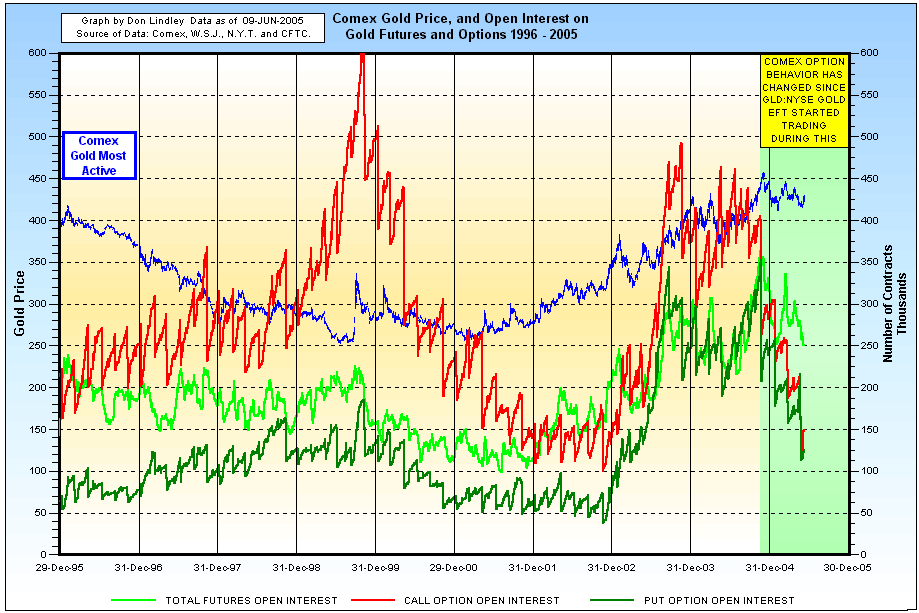
The Commodity Futures Trading Commission issues monthly reports on Bank Participation in the Futures and Options Markets. In May, 26 banks (4 U.S. and 22 Non U.S.) held 43.8% of total COMEX gold futures, with 5.2% long and 38.6% short. In June, 25 banks (4 U.S. and 21 Non U.S.) held 37.4% of the futures, with 6.6% long and 30.8% short. In both months, around a dozen banks held approximately 20% of the open interest in COMEX gold futures options. The June figures are shown in the following table.
BANKS LONG SHORT OPEN FUTURES % FUTURES % INTEREST U.S. 4 1,239 0.5 49,659 19.7 252,151 NON U.S. 21 15,505 5.1 28,054 11.1 ---- ------ --- ------- ---- 25 16,744 6.6 77,713 30.8 LONG SHORT CALLS CALLS U.S. 2 11,410 7.9 11,142 7.7 143,895 NON U.S. 11 15,976 11.1 13,481 9.4 ---- ------ ---- ------- ---- 13 27,386 19.0 24,623 17.1 LONG SHORT PUTS PUTS U.S. 2 10,933 9.1 8,149 6.7 120,730 NON U.S. 11 20,755 17.2 13,501 11.2 ---- ------ ---- ------- ---- 13 31,688 26.3 21,650 17.9With the options reasonably in balance and the banks unlikely to be largely naked on their short futures position, it is reasonable to infer that most of the delta hedges on these futures were executed in the OTC market, where the central banks generally conduct their gold trading operations. The recently concluded Swiss gold sales provide an instructive example.
By selling some of its gold through option programs, the Swiss National Bank managed to realize average prices slightly over spot while at the same time accelerating the availability of its annual WAG quotas for use by the bullion banks. See P.M. Hildebrand, SNB gold sales - lessons and experiences (May 5, 2005), proudly noting:
Apart from spot operations, 350 tonnes were sold through option programs. In a typical program, the buyer committed to buy 50 tonnes of gold spread evenly over several months and to pay the daily average AM and PM London Fixing plus a premium. In order to increase this premium, the SNB accepted to fix a cap to the maximum selling price. In other words, the programs were based on the idea of selling gold on a spot basis and writing out-of-the-money call options. In an effort to obtain competitive premiums, each program was allotted in an auction between three major dealers. Considering the high variance of the bids we received, this auction procedure proved suitable. The realized premium varied between USD 1.4 and USD 3.5 per ounce. These modest premiums reflected the SNB’s prudence in choosing the caps. At the time of the relevant auctions, these were far above the market price. This explains why, despite an overall bullish market, the strike levels were only attained on two occasions, namely in February 2003.
The British gold auctions, timed to coincide with the bimonthly cycle of COMEX gold futures and options, effectively armed the bullion banks to short gold heavily in New York. See Cycles of Manipulation: COMEX Option Expiration Days and BOE Auctions (1/18/2001). As the Swiss sales ended, the British floated a new proposal for gold sales by the International Monetary Fund and the European Central Bank unexpectedly sold some 50 tonnes from its own reserves.
The British proposal ran into considerable opposition, including apparently fatal resistance from the Bush administration, as well as unfavorable comment in major news media. See, e.g., Blair Debt Project, The Wall Street Journal (June 7, 2005). Already facing strong congressional opposition to IMF gold sales, the Bush administration may have decided to duck what promised to be a bruising battle with Senate Minority Leader Harry Reid of Nevada, whose constituency includes a sizable chunk of the U.S. gold mining industry.
The ECB declined to give any reasons for its gold sales, which were the first by that bank from its own reserves rather than by its member banks from their national reserves. What is more, the ECB's sales were not contemplated under the Joint Statement on Gold issued by the ECB and 14 other European central banks (but not the Bank of England) last year to replace the WAG.
With the central banks apparently under increasing strain to meet strong physical demand, the bullion banks have found a new vehicle through which to execute some of their own hedging strategies: the World Gold Council's ETF (streetTRACKS Gold Shares), symbol GLD on the New York Stock Exchange. As Don Lindley observes in the upper right hand corner of his chart, open interest in COMEX gold options has declined sharply since GLD started trading late last year.
At about the same time, an unnamed bullion bank (almost certainly HSBC USA) requested an opinion from the OCC with respect to whether a national bank could trade in GLD for its own account and for the purpose of hedging its exposures in the gold market. See OCC, Interpretive Letter 1013 (January 7, 2005). Subject to satisfying its examiner-in-charge that "appropriate risk management systems [are] in place, the OCC ruled (at p. 7):
The Bank may buy and sell the Gold Shares for its own account under the express authority granted to national banks to buy and sell "exchange, coin, and bullion," and the Gold Shares, as interests in gold, may be used to hedge purchases and sales of gold as part of incidental to the business of banking... .
The failure of GLD's reported holdings of gold (total net asset value in tonnes) to respond to large variations in daily share volume may simply reflect the accumulation of previously issued "baskets" by certain bullion banks whenever investor sales make them available, leaving these banks with new ammunition for future short sales.
Real Money in the Real World. Bob Landis's recent essay, Gold and Deflation: A Dissenting Dissection, stirred some controversy. Apparently there are some, even among the Austrian school, who believe that only legal tender paper currency can presently be deemed money. Gold, they say, was once money and might become so again, but is not today. This view is belied by the manner in which both the currency markets and the central banks actually treat gold.
As discussed at length in The Golden Sextant, forwards and futures on major currencies and gold are arbitraged against each other on the basis of relative interest rates. Every day in the global currency markets gold prices operate as exchange rates and gold lease rates as interest rates, leaving gold to play the role of a stateless currency. Setting aside the special case of silver, which has yet to shed all its monetary characteristics, no other commodity is arbitraged in quite this fashion. Indeed, lease rates are not even quoted except on two others, platinum and palladium, neither of which is properly regarded as a monetary metal.
Accordingly, were gold lease rates to rise above LIBOR or U.S. Treasury rates for the corresponding maturities, dollar gold prices would go into backwardation. Gold could be sold at spot and bought back for future delivery, say in six months or a year, at cheaper prices. At the same time, the yield on gold would exceed that on dollar deposits, effectively making them the new "sterile" asset while gold became the investment of choice for conservative income-oriented investors, not to mention prudent central banks (assuming that phrase is not an oxymoron).
How the major players in the gold market would react to such a development is uncertain. Gold producers would likely accelerate production and deliveries to the market. A negative contango would effectively eliminate producer forward selling. Most importantly, however, counterparty risk would become a major concern. Lenders of gold and purchasers of gold futures or call options would be very sensitive to the perceived ability of their counterparties to meet their payment obligations in physical gold.
In any event, the central banks do not want dollar gold prices in backwardation. Thus they continue to loan gold at concessionary rates below LIBOR or U.S Treasury yields. Indeed, since the central banks are the principal if not only lessors of gold, gold lease rates are at least as much within their control as short-term interest rates. Nick Laird, the proprietor of www.sharelynx.net, has mined his extensive data base to provide a couple of charts to illustrate the point.
Just once and then only briefly, in reaction to the sharp rally in gold prices caused by announcement of the WAG in the fall of 1999, have lease rates have spiked above the corresponding Treasury yields. This event, which caught the major bullion banks completely wrong-footed, resulted in a panic later described by Edward A.J. George, then Governor of the Bank of England (Complaint, ¶ 55):
We looked into the abyss if the gold price rose further. A further rise would have taken down one or several trading houses, which might have taken down all the rest in their wake. Therefore at any price, at any cost, the central banks had to quell the gold price, manage it. It was very difficult to get the gold price under control but we have now succeeded. The U.S. Fed was very active in getting the gold price down. So was the U.K.
Following that incident, lease rates were quickly brought back to customary levels, allowing for a normal contango until early 2001. Then, as the U.S. Federal Reserve reduced short-term interest rates to below 2%, lease rates were brought down to near zero, virtually eliminating volatility and reducing the contango to a derisory 1% or so. Gold lending at such low rates is so inconsistent with any rational calculation of the risk-reward ratio that nobody but a desperate public official would even consider it.
What is more, gold does not interact with interest rates only through lease rates. Absent government interference, gold prices move inversely to long-term real interest rates. See Gibson's Paradox Revisited: Professor Summers Analyzes Gold Prices (8/13/2001). Nick also prepared the chart which accompanied that essay, and since that chart ran only to early 2001, he has graciously updated it for this commentary.
Two points stand out. First, from circa 1996 to 2001, in the face of heavy growth in gold derivatives, the relationship described by Gibson's Paradox failed to hold and gold prices fell along with falling real long-term rates. However, since then as total gold derivatives have leveled off, Gibson's Paradox has reasserted itself and gold prices have turned upward while real rates have remained on an erratic but generally downward trajectory.
Second, what Gibson's Paradox suggests would crush the emerging bull market in gold -- rising real long-term rates -- would also crush the heavily leveraged U.S. economy and in all probability send the world into severe economic depression. Needless to say, the central banks will do everything they can to try to head off that outcome.
The Next Big Bang. In physics, the "big bang" refers to the creation of God's universe, relegating Hiroshima, Nagasaki, and tests of thermonuclear weapons to the status of firecrackers. In finance, the "big bang" is frequently used to describe the deregulation of financial markets in the City of London in 1986 and later in Japan. These, too, will seem as minor events in comparison with the monetary "big bang" that should herald the collapse of the existing international monetary system tied to the U.S. dollar and its replacement by one based on gold.
The mathematics of derivatives assumes: (1) a high degree of market liquidity; and (2) arbitrage will operate to prevent or quickly close opportunities for riskless profit. When these assumptions cease to hold true in markets where large derivatives positions already exist, some sort of financial meltdown is apt to follow.
Bob's recent piece cites several mainstream economists with impeccable credentials, among them Paul Volcker, Peter Peterson and Stephen Roach, for the proposition that the risk of monetary collapse can no longer be lightly dismissed. More recently, and notwithstanding some controversy over precisely what he said in an interview on CNBC, legendary hedge fund manager Julian Robertson, no stranger to irrational markets, seems to have seconded the point. See Global Economic Collapse, www.goldprice.org (June 3, 2005). See also Tiger Management closes, CNN Money (March 30, 2000).
In his commentary of May 17, 2005, silver expert Ted Butler emphasized an important point that applies with equal or greater force to gold:
There will come a time, in my opinion, when the silver market will move into backwardation, with actual warehouse receipts worth more than further out COMEX delivery months. There will be a great temptation to sell the warehouse receipts and simultaneously buy a cheaper futures month, take delivery again and pocket the difference. It will appear to be the surest money one can make. But it all hinges on there being no problems with getting delivery on the purchased futures month. If the exchange pulls a trick in silver like they did in palladium, such a trade could backfire completely. Be careful before you part with your real silver, it may be impossible to get back. [Emphasis supplied.]
Because above-ground inventories of gold are far larger than those of silver, gold is less likely than the older monetary metal to go into backwardation. However, the likelihood of either metal presenting opportunities for "riskless" arbitrage to individual investors is vanishingly small.
Nothing would be a surer sign that the central banks have lost control of the global fiat money system than dollar gold prices in clear backwardation on the COMEX, as for example platinum prices are today. Gold prices in backwardation would imply not merely a shortage of liquidity in the gold market, especially the near term physical market, but also a withdrawal of the central banks from gold lending, due to lack of supply and/or an increased perception of financial or systemic risk.
On a more fundamental level, dollar gold prices in backwardation insult common sense. They imply that the dollar is better than gold notwithstanding that it ceased to be as good as gold years ago. Ironically, from a market view, gold will likely come closest to being just another commodity precisely when the U.S. dollar enters its terminal decline. In that event, no assets will provide a more certain bang for the buck (or for the euro or the yen) than physical gold and silver, the traditional monetary metals, which carry no counterparty risk precisely because they are no one's liability.
